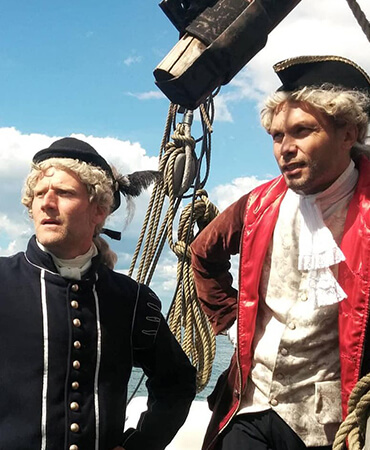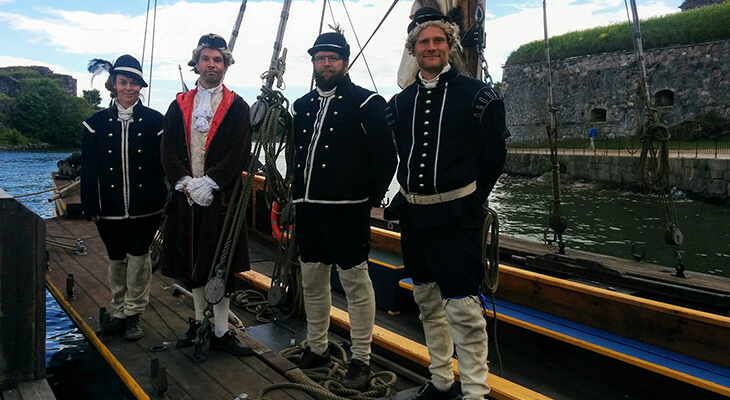The War
 Sweden had lost large areas to Russia in the aftermath of the Great Northern War and the Hat of War. However, King Gustav III of Sweden nurtured hope for the restoration of the old territories to Sweden and, as a result, for Sweden to be brought back into the ranks of the great powers. After Russia got into a war with Turkey in 1787, Gustav III saw his opportunity come: when the gaze in the neighboring country was focused on the Black Sea, it would be easy for Sweden to operate in the north. To win the war, the Swedish navy should take over the dominance of the Baltic Sea by surprise Russia. In the spring of 1788, the Swedish navy began equipment work for the war in Karlskrona and Stockholm as well as on the Viapori red. This came as a surprise to many, as the Swedish navy was far from ready for war and the king had no right to start a war. On June 9, 1788, the Navy lifted its anchor from the Karlskrona Red, and the Stockholm Archipelago Squadron raised its sails under the command of the King on June 23. The war had begun.
Sweden had lost large areas to Russia in the aftermath of the Great Northern War and the Hat of War. However, King Gustav III of Sweden nurtured hope for the restoration of the old territories to Sweden and, as a result, for Sweden to be brought back into the ranks of the great powers. After Russia got into a war with Turkey in 1787, Gustav III saw his opportunity come: when the gaze in the neighboring country was focused on the Black Sea, it would be easy for Sweden to operate in the north. To win the war, the Swedish navy should take over the dominance of the Baltic Sea by surprise Russia. In the spring of 1788, the Swedish navy began equipment work for the war in Karlskrona and Stockholm as well as on the Viapori red. This came as a surprise to many, as the Swedish navy was far from ready for war and the king had no right to start a war. On June 9, 1788, the Navy lifted its anchor from the Karlskrona Red, and the Stockholm Archipelago Squadron raised its sails under the command of the King on June 23. The war had begun.
Artillery sloops in war 1788-90
In the War of Gustav III, artillery magnifiers had many different functions. They were used, for example, to perform deception and intelligence missions. One of the tasks of the artillery magnifiers was also to help damaged ships and signal the order of battle. Given their size, the sloops were able to cause a surprisingly large amount of damage to even larger ships, especially ship rigging and the weakest parts of the hull, without suffering greater damage themselves. The reason for this was clear: after the attack, the artillery loupers were able to escape to the barren archipelago, to which the larger ships had no matter, and then to renew their attack quickly. Due to their small size and shallow draft, they were able to make surprising attacks on the enemy’s side or back particularly well. Although the king had fallen in love with the slups designed by Fredrik Henrik af Chapman before the war, there were only 28 of them in the Stockholm squadron and 27 in the Viapori squadron when the war began. During the war, however, the benefits of the snuff were noticed, and in a short time a considerable number of more were built.

The second naval battle of the Swedish Strait
At the beginning of July 1790, the Swedish navy had survived the Russian siege of the Vyborg Bay, despite a seemingly desperate situation. However, the ships were scattered in the archipelago, so Gustav III ordered the entire fleet to gather in the Swedish Strait. The king began to expect an immediate attack by the Russian navy, and it soon became apparent that the enemy would attack the Swedish Strait from the south. Artillery loupes began to signal the naval battle order to other ships. On July 9, a chambermaid woke up with a royal announcement that the Russians were about to launch an attack.
After the summer of war, the archipelago fleet consisted of a total of 195 warships, 99 of which were artillery loupes. The tactics used in combat would thus be largely based on the contribution of small artillery loupes. The battle order used in the Swedish Strait sought to besiege enemy ships. Artillery magnifiers were placed on either side of the larger ships, leaving enemy ships trapped between the resulting sites. The purpose of the artillery loupe commander Hjelmstjerna was to turn around the right side of the Russians and thus attack the backs of enemy ships. The maneuver of the Swedish snuff came as a complete surprise to the commander of the Russian archipelago navy, Nassau-Siegen. As a result, some Russian ships misunderstood the orders that followed the attack, causing many ships to abandon the battle and set out to retreat. At the same time, the sea began to reach, thus stirring the center of the Russian navy and driving it towards the Swedish ships. The battle continued well into midnight until the Russian navy fled the Swedish Strait.
The contribution of artillery loupes was a decisive factor in the victory of the Swedish navy. The second battle of the Swedish Strait was the most victorious and at the same time the largest naval battle ever waged in the Baltic Sea. Peace was signed in Värälä on August 14, 1790. No actual border changes were agreed in the agreement. Despite this, peace was a political victory for Gustav III, as the treaty permanently forbade Russia from becoming entangled in Swedish domestic affairs.
© 2013 Tykkisluuppi
